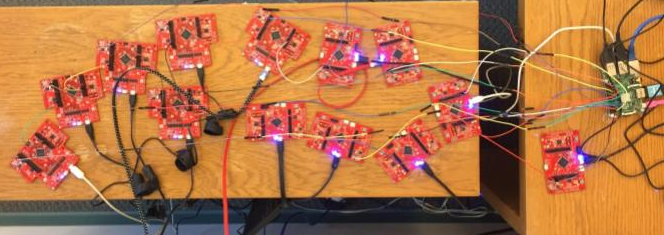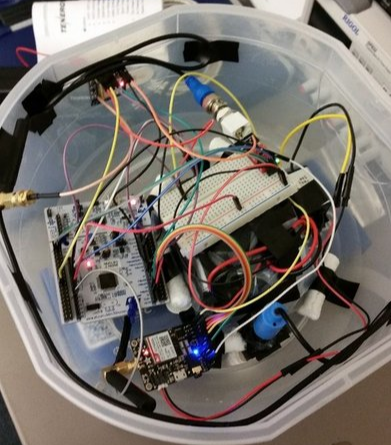About Me
I am a first-year CS PhD student at Stanford, interested in security, systems, and formal methods.
Prior to starting my PhD, I was a software engineer at Google working on credential infrastructure security.
I was previously an undergrad at Stanford, and did research on the Tock operating system focused on implementing the 6LoWPAN networking stack. I was also the president of the Applied Cybersecurity club, and participated in the CCDC and CPTC competitions.
Publications and Patents
-
DCOSS 2020 Paper: Design Considerations for Low Power Internet Protocols. Hudson Ayers, Paul Crews, Hubert Teo, Conor McAvity, Philip Levis, Amit Levy. International Conference on Distributed Computing in Sensor Systems (DCOSS), May 2020.
-
AT&T Broadcast Security Patent: Mechanisms and apparatus for securing broadcast content distribution of time-sensitive data. Julius Mueller, Paul T. Crews. Filed February 2019. Issued US Patent 11,424,923 August 2022.
Workshops and Talks
-
NESVD 2022 Talk: Defining recoverability for arbitrary security properties. Paul Crews, Christopher Hahn, Jon McCune, Caroline Trippel. New England Systems Verification Day (NESVD), October 2022.
-
USENIX Security 2022 Poster: A Formal Foundation for Recoverability. Paul Crews. USENIX Security Symposium, August 2022.
-
YArch Workshop 2022 (Slides, Poster): Designing SGX Applications for Recoverability. Paul Crews. Young Architects Workshop (YArch’22) at ASPLOS, February 2022.
-
SenSys 2018 Poster: Design Considerations for Low Power Internet Protocols. Hudson Ayers, Paul Thomas Crews, Hubert Hua Kian Teo, Conor McAvity, Amit Levy, Philip Levis. ACM Conference on Embedded Networked Sensor Systems (SenSys), November 2018.
-
SOSP 2017 Tutorial: SOSP Tutorial: Tock Operating System. Amit Levy, Daniel B. Giffin, Bradford Campbell, Paul Thomas Crews, Mateo Garcia, Branden Ghena, Shane Leonard, Pat Pannuto, Hubert Teo, Prabal Dutta, Philip Levis. ACM Symposium on Operating Systems Principles (SOSP), October 2017.
-
CURIS 2017 Poster: Bringing IP Networking to the Internet of Things. Paul Crews, Mateo Garcia, Hubert Teo. Stanford Undergraduate Research Internship in Computer Science (CURIS), September 2017.
Honors and Awards
- Siebel Scholar, 2019
- Collegiate Penetration Testing Competition, 2018 (1st Place)
- Collegiate Penetration Testing Competition, 2017 (1st Place)
Projects
A Formal Foundation for Recoverability (2021 - Present)
I have been leading a research project collaboration between Google and Stanford on how to design systems that can mitigate and recover from a compromise. This work is still ongoing, and has resulted in a poster at USENIX Security 2022.
Tock Operating System (2017 - 2018)
While a student at Stanford, I worked on the Tock research project. Tock is an embedded operating system written in Rust, which leverages Rust’s type system to provide security guarantees with low overhead. I helped implement the 6LoWPAN protocol and networking stack in Tock. Through this work, we discovered that other implementations of 6LoWPAN are not interoperable, resulting in a paper at DCOSS in 2020.
Class Projects
Below are a few major class projects I worked on while a student at Stanford.
Senior Project: Deluge Protocol on Tock
For my senior project, I implemented the Deluge protocol on the Tock platform. This protocol is used for efficiently updating binaries in a wireless mesh network. This project extended the single-binary Deluge to support updating multiple binaries simultaneously.
CS244B: Trickle Algorithm on Tock

For my final project in CS 244B (Distributed Systems), my group implemented a modified version of the Trickle algorithm which aims for eventual consistency in low-power wireless networks. As part of our modifications, we enabled some portion of nodes in the network to completely enter sleep mode, rather than requiring all nodes remain in the listen state. This improved the power efficiency of the network while still retaining eventual consistency.
CS 241: Low-Power Wireless Water Quality Measurement
For my final project in CS 241 (Embedded Systems), my group created a low-power wireless water quality monitor system. We implemented a test-bed on the STM Nucleo microcontroller, which was aimed at allowing different sensors to be plugged into the board. The system would then periodically transmit sensor measurements over GSM. We published an online tutorial demonstrating how we implemented this project.
Leadership
Applied Cybersecurity Club

I was president of the Stanford Applied Cybersecurity Club from 2017 until 2019, and I helped establish the club as an official Stanford student orgianization in 2018. As president, I was responsible for organizing weekly talks, workshops, and events to help interested students learn about computer security. I also helped run and participated in collegiate computer security competitions with other members of the club, winning first place at the Collegiate Penetration Testing Competition (CPTC) in 2017 and 2018.
